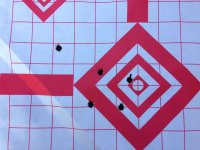petemacmahon
Member
I just picked up a 1928 or 1929 (still need to ascertain which is the year stamp on the base of the barrel) Remington model 14 pump action rifle in 35 Remington. I am not a collector of safe queens and so this will be out hunting this coming deer season if it works ok (I have yet to get it to the range).
Coincidentally, I am just now sorting through a couple bags of wheat pennies my Dad gave me like 30 years ago. I have already found a few 1928 & 1929 pennies to put in my pocket.
So, next up, since I don't yet own any pre-war Smith & Wesson revolvers, I'm thinking the time has come to get a shooter grade to round out my hunting outfit!!
Now, to me, this will probably mean a 44 hand ejector 3rd model. But posting here to elicit other opinions.
So, shoot - what would be the best revolver for my belt?? Remember, it must be capable of killing a white tail deer under perfect conditions ( I have already killed deer with my 696, so please don't waste any time trying to school me on the ballistics of the 44 special) and it must have been made around the same time as the rifle.
Coincidentally, I am just now sorting through a couple bags of wheat pennies my Dad gave me like 30 years ago. I have already found a few 1928 & 1929 pennies to put in my pocket.
So, next up, since I don't yet own any pre-war Smith & Wesson revolvers, I'm thinking the time has come to get a shooter grade to round out my hunting outfit!!
Now, to me, this will probably mean a 44 hand ejector 3rd model. But posting here to elicit other opinions.
So, shoot - what would be the best revolver for my belt?? Remember, it must be capable of killing a white tail deer under perfect conditions ( I have already killed deer with my 696, so please don't waste any time trying to school me on the ballistics of the 44 special) and it must have been made around the same time as the rifle.






